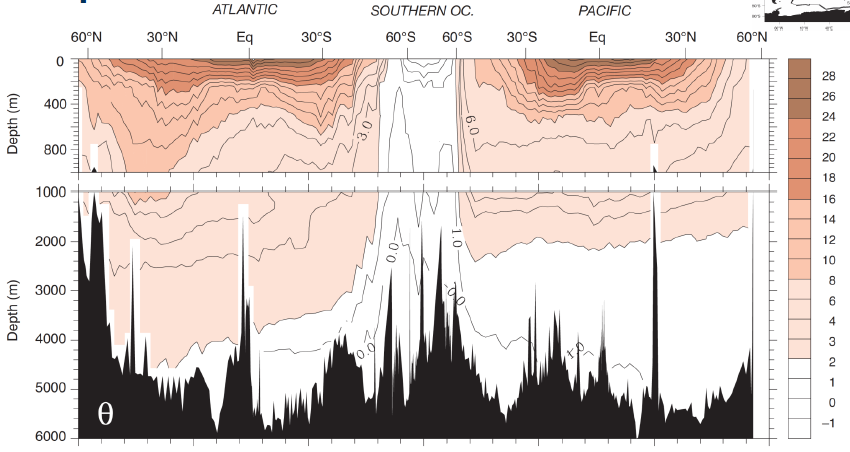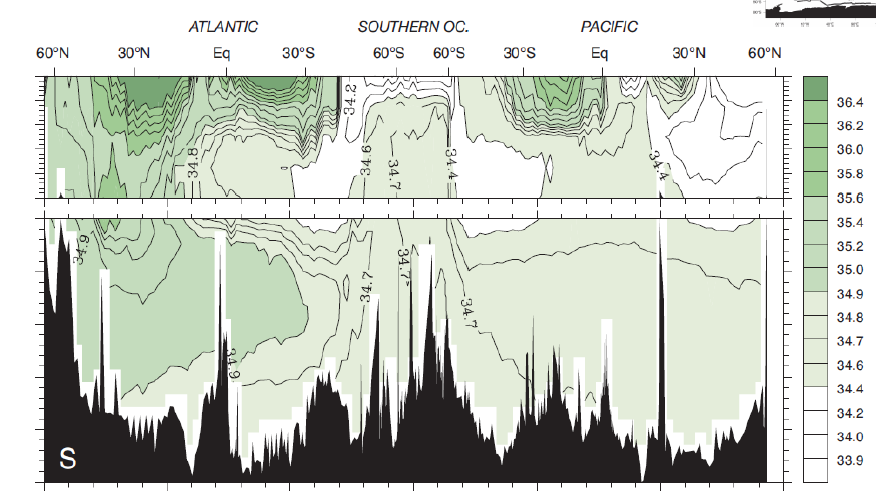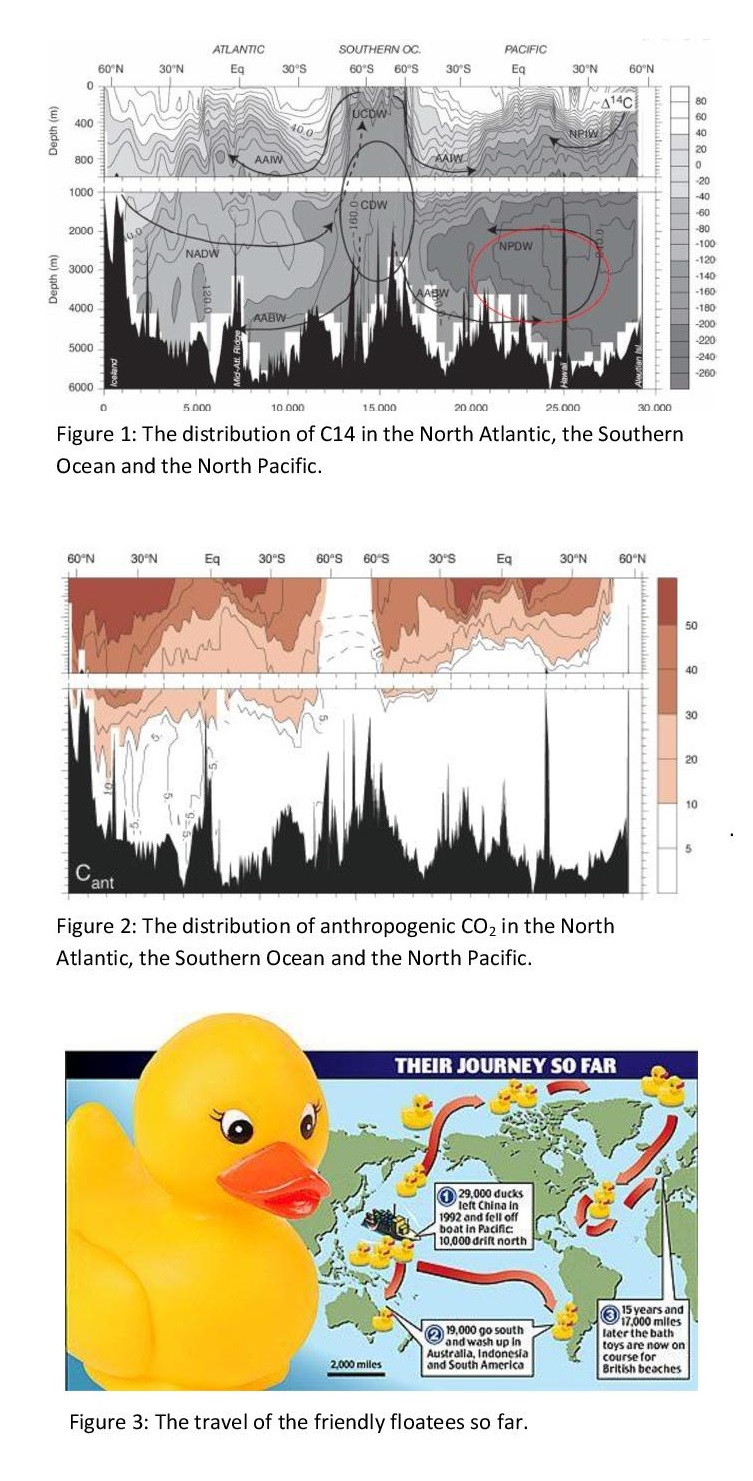Global Ocean Circulation Tracer
Author: Hannah Wey, Marja Gächter
Six different tracers are presented here: Temperature, salinity, the CFC, the C14 and the anthropogenic CO2-method that were discussed in the lecture, and additionally the “friendly Floatees”.
Potential temperature and salinity are so called conservative tracers. This means that they remain stable over time and are only altered by processes occuring at the boundaries of the oceans. So the salinity is conservative except at the ocean surface. Here it is increased by evaporation and decreased by rain and snow. The temperature is also not conservative at the surface due to heatfluxes from and to the atmosphere (radiation). There are different types of temperature: In situ temperature is not a conservative tracer, whereas the potential temperature is (it's a theoretically calculated value). The so called conservative temperature is also a conservative tracer. It is proportional to enthalpy and therefore to the total heat content of the water parcel and also takes salinity into account.
A water mass that has a certain potential temperature and salinity that will not be influenced by chemical processes and will only be changed in these properties if it gets mixed up with another water mass with different physical properties. Because mixing inside the deep ocean is relatively slow, water masses can be traced back to their origin according to their typical potential temperature and salinity. Through this different water masses can be identified. For details see Ocean Water Masses. The characteristic of potential temperature and salinity allows the use of T-S diagrams to track different water masses in an ocean profile T-S Diagram.
Temperature distribution in the ocean:
Salinity distribution in the ocean:
Non-conservative tracers change trough physical, chemical and biological processes and are not stable over time. A lot of chemicals are non-conservative tracers.
 CFCs (chlorofluorocarbon) were used from the late 19th century to the late 1970s as additives for example in refrigerators and spray cans. They are not generated in a natural way but originate in anthropogenic emissions. These chemicals were banned once it was clear the release destroys the ozone layer of the earth. CFCs are only distributed according to physical laws, therefore they can be used to estimate the age of a specific water body: The concentration of CFC in water depends on the contact to the surface, distribution and mixing: Old water bodies that were not in contact with the surface since the chemicals emerged have a low CFC concentration. Water bodies on the surface have a higher concentration.
CFCs (chlorofluorocarbon) were used from the late 19th century to the late 1970s as additives for example in refrigerators and spray cans. They are not generated in a natural way but originate in anthropogenic emissions. These chemicals were banned once it was clear the release destroys the ozone layer of the earth. CFCs are only distributed according to physical laws, therefore they can be used to estimate the age of a specific water body: The concentration of CFC in water depends on the contact to the surface, distribution and mixing: Old water bodies that were not in contact with the surface since the chemicals emerged have a low CFC concentration. Water bodies on the surface have a higher concentration.
As with the latter method, the age (this means: the time that evolved since the water was in contact with the atmosphere) of a water body can be estimated with the C14-method: C14 is naturally abounding but also nuclear testing in the last 60 years has increased the concentration. Finally C14 goes through radioactive decay. Therefore water bodies at the surface have a high C14 concentration. Old water bodies as in the Pacific Ocean have a low C14 concentration, as can be in figure 1. The concentration is always given compared to a standard sample!
Anthropogenic CO2 can also be used as a tracer, but it is more difficult as it cannot easily be distinguished between the latter and natural CO2. As anthropogenic CO2 has been in the atmosphere for about 150 years, there was not enough time to transport it to the deep ocean (figure 2). The concentration in deeper layers is only increased close to the equator, where CO2 is uptaken by plants for photosynthesis.
In January 1992 a container ship loaded with bath toys had an accident in the North Pacific Ocean: During a storm some containers got lost and toys like yellow ducks and green frogs were released. Oceanographers from Seattle that were working on a ocean surface current model started to trace these objects. In the next few years the toys were found all over the world, but mainly on the West coast of Alaska. With this information the research team could predict their movement.
To conclude tracers can be used to estimate the age of a water body and/or to identify the flow direction of the latter.
External references:
- Wikipedia. 2014. “Friendly Floatees.” Accessed March 25. http://de.wikipedia.org/wiki/Friendly_Floatees.
- Mail online. 2014. “The Duckirk Landings.” Accessed January 4. http://www.dailymail.co.uk/travel/article-596246/The-Duckirk-landings.html.//
- Ocean Circulation, Open University; chapter 6, p.190-255
Comments
- Please revise following points: — Samuel Eberenz 2015/03/10 12:47
- briefly mention temperature and salinity as tracers and link to the articles on Ocean Water Masses and T-S Diagram.
- Also mention conservative and non-conservative tracers here.